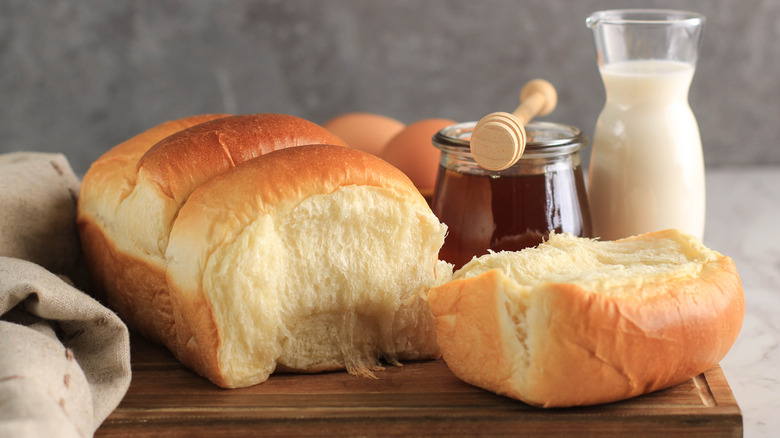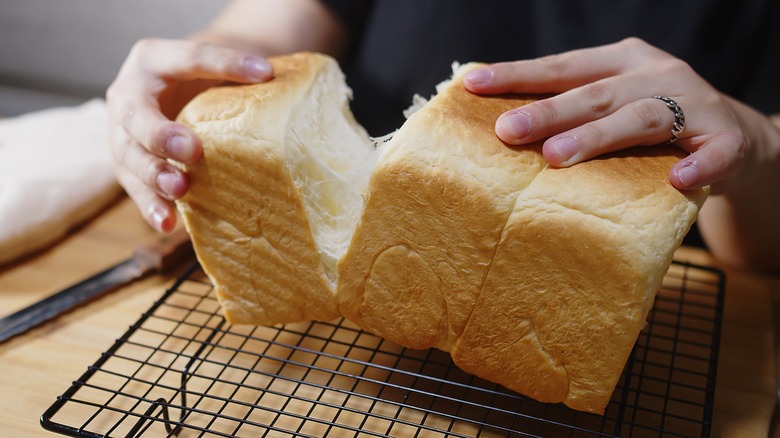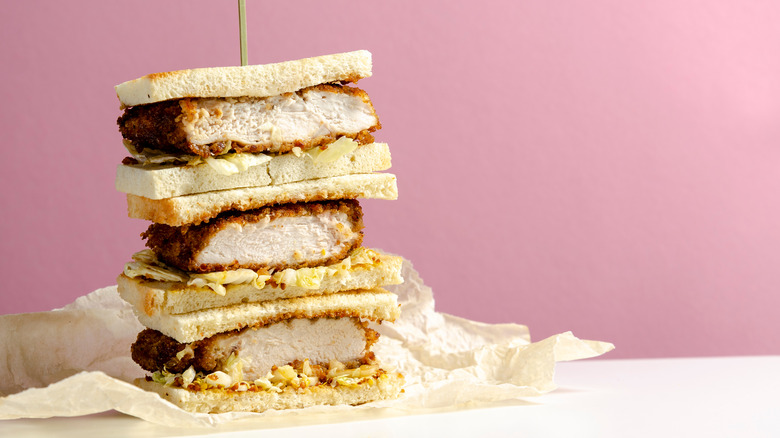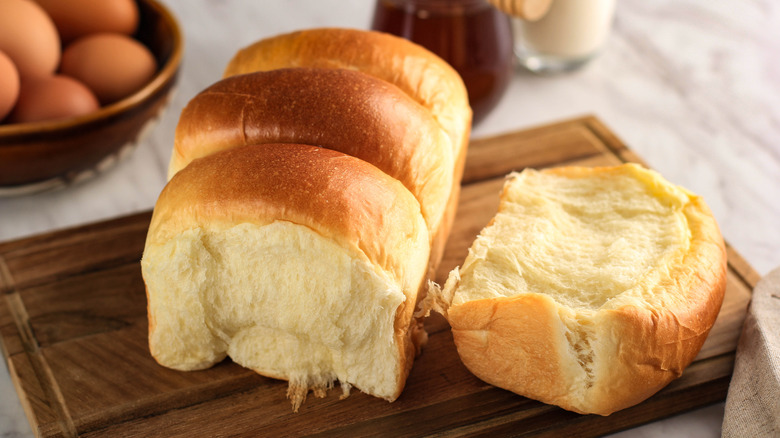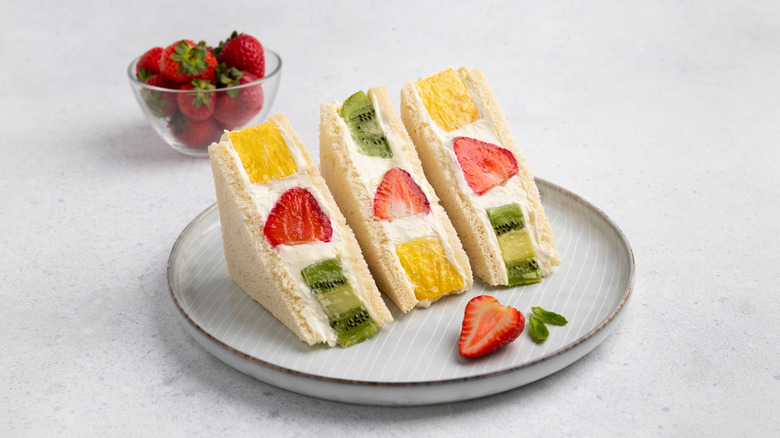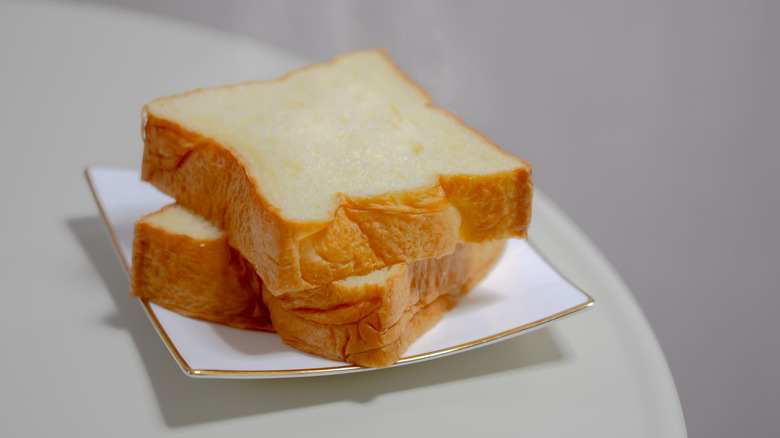What Is Milk Bread And What Is It Made Of?
Imagine a white bread: The classic bread that made perfectly crisp grilled cheeses before sourdough ever became a fad — so soft and airy in its untoasted form that it almost gives way under your fingers. Now, imagine a bread that, though similar in appearance, is fattier and far more flavorful than that plain old white bread: That's the milk bread that has been taking bakeries and restaurants in the U.S. by storm (via Bon Appétit).
A sandwich staple from Japan, milk bread has been gaining recognition in the U.S. and with it, the fluffy bread's demand has likewise soared. "We didn't even think of putting whole loaves on the menu until we started getting a lot of requests," pastry chef Yoshie Shirakawa of New York's Pâtisserie Fouet told Bon Appétit in 2019. The LA-based Konbi, famous for its Japanese sandwiches, also depends on milk bread — the recipe for which took 20 tries and six months to perfect – as its star component.
Whether you see the Japanese bread listed under the name of Hokkaido milk bread or shokupan, it always means one thing: a light, soft, and milky bread that is as fluffy as a cloud (via Healthy Nibbles).
How is milk bread made?
Milk bread, or shokupan as it's known in Japan, often comes shaped as a rectangular loaf which, unlike its crustier counterparts, has only a thin golden exterior. When the loaf is cut into thick squares, the slices reveal a milky white interior that is incredibly fluffy (via Bloomberg). A good milk bread, the Japan Times says, is mochimochi — or similar to the softness, bounciness, and resilience of glutinous rice mochi balls.
It is widely believed that the secret to making milk bread was adopted by Japanese bakers in the 20th century, based on a method that was used in China to bake soft, delicate, and sweet breads. According to this method, a yudane, or tangzhong — a roux cooked from a 1:5 ratio of flour and water and sometimes milk at 149 degrees — is used as the base for milk bread and gives the bread its stretchy, chewy, and bouncy texture (via SBS). To the roux, the usual flour, eggs, salt, sugar, yeast, butter, and milk are added in, per MasterClass. Because of the tangzhong, the flour in the milk bread can absorb more liquid, which, the site says, is what makes the bread moist. Along with milk, adding fresh cream will make the loaf lusher, while mascarpone will make it smoother. SBS points out that the bread usually comes in one of two shapes: with round mountainous tops known as yama, or with flat and squared corners known as kaku. Regardless of the details, the key to a milk bread is in the tangzhong.
A British baker may have invented milk bread
Although milk bread uses the Chinese technique of baking bread with tangzhong, a technique later adopted and popularized by Japan, some theories indicate that the creator of this unmistakably fluffy bread was British. Bread itself is believed to have made its way into the rice-loving country of Japan in 1543, when the Portuguese brought guns and the concept of baked bread (via Web Japan). This is perhaps why shokupan gets the pan part of its name from the Portuguese word for bread — pao. Despite making its way into Japan in the 1500s, bread only became popular in the late-19th century with the coming of British craftsmen who brought with them the habit of baking loaves of bread in tins.
Annie Sheng, an anthropologist who studies Asian bread at Cornell University, tells Bon Appétit that even though it's hard to say for sure when and where exactly the recipe for the bread originated, or how it came to Japan, it might have been created by a British baker named Robert Clarke who opened his Yokohama Bakery in Japan in 1862.
World War II may have popularized milk bread
As history professor Eric Rath recounted in an interview with Bon Appétit, another theory about the slow rise of bread's popularity in Japan (despite it being introduced to the country fairly early on) is that the average home in 16th century Japan did not have an oven, making bread baking next to impossible. This is why bread at the time was mostly considered a snack food, and so sweet, dessert-like varieties were particularly popular — including anpan buns stuffed with adzuki beans, which were invented in 1874.
It was only during World War II, when rice became harder and more expensive to find, that people in Japan started looking towards breads like milk bread as a staple food. Along with the fact that rice was rationed, Japan was also seeing an influx of items like yeast and wheat from the U.S. This is why rice saw a 50% drop in consumption by the 1950s, just as bread became a staple on the dinner table. In the 1970s, the bread started being used for Japanese convenience store sandwiches, and by the late '90s and early '00s, milk bread had finally reached the States.
How can you use milk bread?
Japan Times says that the reason why milk bread is so popular in Japan is because it is very much like a bowl of steamed white rice, in that both present a blank canvas for other ingredients and their flavors to shine. Traditional methods of using milk bread include sandwiching potato salad or a mixture of fruit and cream between two of the pillowy slices. Dessert-like fruit sandos in particular, are a popular food on the go to pick up from vending machines or convenience stores in Japan (via The Guardian).
Taste also makes a case for milk bread as the bread to choose when making French toast (in this case, with a generous filling of gooey black sesame butter inside). The towering Shibuya honey toast — also known as brick toast — popular across Japan, Taiwan, and Singapore that is meant to be served with heaps of honey, fruit, and toppings also uses milk bread as its base (per Saveur). When deep-fried, milk bread keeps crispy enough on the outside to hold a filling of liquid curry inside without compromising on its sought-after fluffy interior. Want to try your own edible experiment? Then find a place like Konbi, which also sells whole loaves, and use milk bread to make an unbeatable Japanese sando at home.
Differences between milk bread, white bread, and brioche
Unlike its whole wheat-based, darkly-browned, and crusty counterparts, lighter breads with thin, golden crusts like brioche, white bread, and milk bread are often mistaken for each other. Despite their similarities in appearance, the three breads are very different from each other. In terms of taste, shokupan is sweeter than white bread, but not quite as sweet as brioche (via The Guardian). When compared to white bread, the author of "Modernist Bread," Larissa Zhou tells Bon Appétit that shokupan has about seven times more fat from milk and butter.
Reddit threads discussing the fine nuances of the three breads have come to the conclusion that the use of a tangzhong roux also differentiates milk bread from brioche, whereas the latter usually depends on the use of more butter. The biggest visual give-away for milk bread, however, is the ample thickness of how its slices are served — a typical slice of milk bread will rarely ever fit inside a narrow pop-up toaster.
